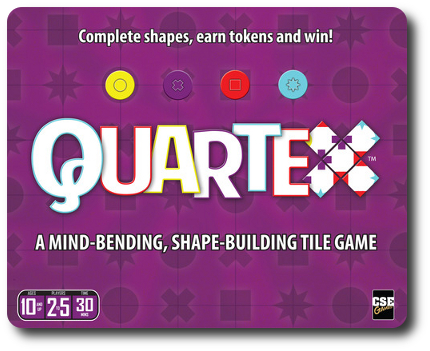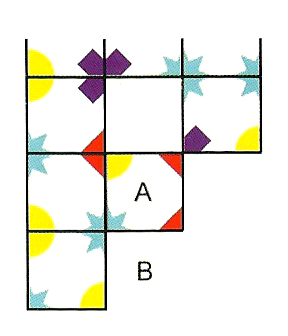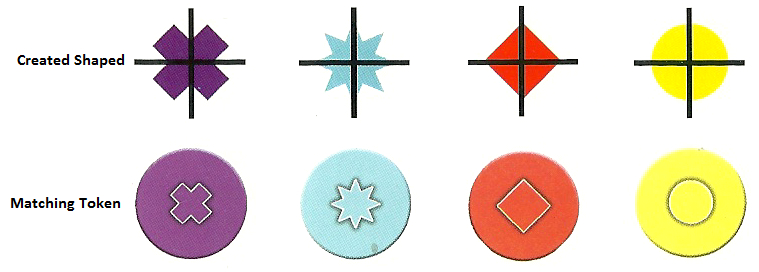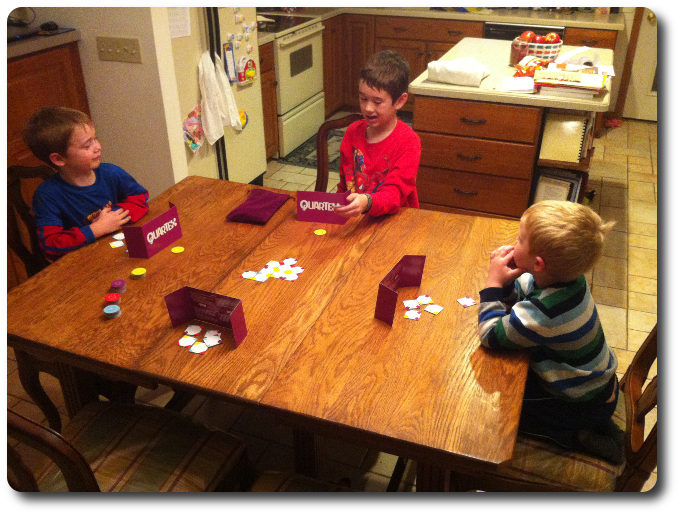
The Basics:
- For ages 6 and up (publisher suggests 8+)
- For 2 to 5 players
- Approximately 30 minutes to complete
Geek Skills:
- Counting & Math
- Logical & Critical Decision Making
- Pattern/Color Matching
- Visuospatial Skills
- Hand/Resource Management
Learning Curve:
- Child – Easy
- Adult – Easy
Theme & Narrative:
- None
Endorsements:
- Gamer Geek mixed!
- Parent Geek approved!
- Child Geek approved!
Overview
The human mind sees patterns in everything. We are hardwired to make associations with what we encounter in our daily lives, be it a person, a place, or a thing. This helps us make choices by matching something new to something we already know. In this game, every piece of the puzzle you add will make the “big picture” all the more difficult to observe. Get ready to think hard and see patterns where none yet exist!
Quartex, designed by Tim W. K. Brown and published by CSE Games, is comprised of 55 double-sided square tiles, 40 double-sided round tokens (in 4 different colors, 10 per color), 5 player shields (which also serve as a quick player reference guide), and 1 draw bag. The tiles and tokens are made of thick and durable cardboard. The colors on the tiles are bright and attract the eye. A matching symbol is provided on each colored token, making the game easy to play for those who have difficulty seeing colors.
Game Set Up
To set up the game, first give each player 1 player shield. These should be placed so they hide a small area in front of the player from their opponents.
Second, separate and stack the round tokens into their different colors. When done, there should be 1 stack of blue (starburst), 1 stack of purple (plus), 1 stack of yellow (circle), and 1 stack of red (square). Place these stacks to one side of the playing area and within easy reach of at least one player. Wherever the stacks are placed, they should be visible to all the players.
Third, place all the square tiles in the draw bag and mix them up. Depending on the number of players, randomly draw and set to one side a number of tiles. The removed tiles should be visible to all players. I suggest you place them by the tokens.
- If playing with 2 to 3 players, draw and set aside 1 tile.
- If playing with 4 players, draw and set aside 3 tiles.
- If playing with 5 players, do not draw any tiles.
Fourth, each player now randomly draws 5 tiles from the draw back and places them behind their player shield.
That’s it for game set up. Determine who will go first and give them the draw bag.
Playing the Game
Quartex is played in turns with no set number of turns or rounds per game. On a player’s turn, they will complete the following sequential steps.
Step 1: Place a Tile
The first step is to select a tile and place it to the center playing area. If this is the first tile to be placed, it can be any tile the player likes. After that, players must adhere to a few rules when placing a tile.
- Each tile must be touching at least 1 full side of another tile.
- The colors and shapes that are found on the four corners of each tile must match any adjacent tiles, including diagonal tiles where the corners meet.
The tiles are double-sided and have a mirror image of what is shown on the opposite side. On each of the four corners is a colored shape. Some tiles might have more than one of the same colored shape. The object for the player is to place the tiles so they can complete a symbol comprised of one color.
For example, the following image demonstrates an incorrect tile placement (“A”). Note how the tile is placed so the sides are matching correctly, but not the colored symbols. The player can correct this by flipping the tile over (remember, all tiles have a mirror image of its opposite side) and placing it in the area marked as “B”.

It’s possible that a player might not be able to place any of their tiles. If the player believes that none of their tiles can be placed legally, they announce it to the table and then remove their player shield. This allows their opponents to see their current tiles. The player’s opponents can help the player place a tile if they so choose.
If the player’s opponents do find a legal play for the player’s tiles, the player must play the tile and their turn now continues as normal (go to step 2).
If the player’s opponents agree that no legal placement is possible or if they simply choose not to help, the player replaces their player shield and draws 5 new tiles from the draw bag. The player then places their old tiles back into the draw bag for others to draw. If the player is unable to draw 5 new tiles, they draw as many as they can and then the player chooses which of their old tiles they will place back in draw bag. The player should now either have 5 new tiles or a mixed of old and new tiles in front of them. This completes the player’s turn if they were unable to place a tile. The draw bag is passed to the next player in turn order sequence.
If the last tile has been drawn from the bag and the player is unable to play a tile, they are out for the duration of the game. The player does not return their tiles to the draw bag. Any remaining tiles the player has will reduce their total points at the end of the game. This is referred to as a “Pass”, which is a term our groups came up with to make teaching the game easier.
Step 2: Score a Tile
A player might complete a shape during their turn. For example, on their turn the player places their tile (“C)” in the open space (“D”). The result is a completed blue starburst. Note how the newly placed tile matches not only the adjacent sides of the surrounding tiles, but also matches any corners that the new tile is touching (“E”).

A complete shape will score the player 1 matching colored token of the same color. The player identifies the created shape or shapes (players could create more than one on their turn) and then collects the matching tokens, one per shape created. The tokens are placed in front of the player’s shield and are visible to the player’s opponents. If there are no more tokens of the specific color, the player does not collect a token.

Step 3: Draw a New Tile
The last action a player will take if they are able to complete a full turn is to draw a new tile from the draw bag. The player draws a tile at random and places is behind their player shield. If there are no more tiles in the draw bag, the player skips this steps.
This completes the player’s turn. The draw bag is passed to the next player in turn order sequence.
Ending the Game and Scoring
The endgame is triggered when the draw bag no longer contains any tiles. Play continues until all players use their tiles or all the remaining players in the game pass. Players then score their points.
Each token is worth a number of points equal to the number of unclaimed tokens of the same color. A quick look at the stacks of unclaimed tokens will tell the players exactly how much each of their tokens is worth. For example, if the stack of tokens contained 3 purple pluses, 0 blue starburst, 1 red square, and 2 yellow circles, a player’s tokens would be worth the following values at the end of the game:
- Each purple plus = 3 points
- Each blue starburst = 0 points
- Each red square = 1 point
- Each yellow circle = 2 points
In this way, the more of a specific color that is created and collected, the less it’s worth at the end of the game! Awesome. If the player was unable to play a tile and could not draw a new tile resulting in a Pass, they will count their tokens as normal, but will subtract 1 point for every tile they still have behind their screen.
The winner is the player with the most points.
To learn more about Quartex, visit the game’s official web page.
Prediction
Quartex is similar to another color/pattern tile matching game that I play a great deal with family and friends, Qwirkle. However, in Qwirkle, a player is asked to match a complete color and shape. In Quartex, a player is required to match a color and shape on four points that they create. This makes Quartex a more complicated game as far as piece placement goes, but not any more difficult to learn how to play. Since all of my children, my family, and friends know how to play Qwirkle, I don’t see anyone having problems sitting down and learning how to play Quartex. I’m certain my 4-year-old will be able to play, too, but will need some help due to the higher level of pattern matching complexity.
Given the above, I think Quartex will do very well with all our group members except the more hardcore Gamer Geeks. There is a lot of logical thinking in Quartex, but not much in the way of strategy or tactics. Players cannot really set up their next move, as they are dependent on what is played before their turn. Observing opponents won’t give players much information, either, as their opponents are reacting to previous plays, too. At most, a player will need to keep a sharp eye on the tokens. This will help them determine which colors to work towards to maximize their points. This aspect of the game has a very Alhambra feel to it, wherein the amount of points a player collects is directly dependent on how many of the tiles are collected by all the players. In short, the game is very casual, but focused. This should appeal to many of our players except those who want a game that allows for indepth strategic and tactical play.
Teaching Quartex is best done by providing several visual examples. Randomly select a few tiles and show the players how patters are made. Make certain you note the tile placement rules and how the scoring is done at the end of the game. Do not let players think that the number of points they have is based on the number of tokens they have collected. The amount of points is equal to the number of tokens NOT claimed. If you fail to make certain players understand this important point, you might have some grumpy friends at the end of the game playing session.
After teaching Quartex to all three of my little geeks, I asked them their thoughts on the game so far.
“I like games like this. Reminds me of that other game we play.” ~ Liam (gae 9)
“It reminds me of the puzzles I do on the floor.” ~ Nyhus (age 6)
“Let’s play, Daddy, but you will help me? Are we on a team?” ~ Ronan (age 4)
Looks like my little geeks are ready to go. Let’s play Quartex and see if we love it or hate it.
Final Word
All the Child Geeks enjoyed Quartex, became very frustrated at times, but never wanted to stop playing. The game’s length is perfect and including the rule that allows players to help each other was a brilliant bit of foresight on the game designer’s part. There were many times that the younger Child Geeks got stuck and they needed their opponents’ help. Of course, being children, everyone helped them out. On this point, I cannot recommend Quartex for players as young as 4-years-old. I spent more time playing my 4-year-old’s game than him. This started to wear a bit thin with the rest of the table as it appeared I was playing favorites and giving the youngest little geek a real advantage. My 6-year-old has no problem playing and only needed a little help. The same goes for my 9-year-old. According to one of the Child Geeks, “This can be a really hard game or a really easy one. It all depends on what is on the table and what I have behind my shield.” Well put! The game was approved by all the Child Geeks.

My oldest complains about his younger brother’s last tile placement – Note the smirk on the younger brother’s face…
The Parent Geeks simply adored Quartex and both laughed and growled during game play. They did not help each other as much when the game was played with just their peers, which was pretty funny to observe. All the Parent Geeks understood that the number of points they earned was dependent on what tokens were left at the end of the game. Not once did I see a Parent Geek assist another adult if it would result in a token being claimed. Me included. This provided a great deal of casual and competitive fun at the table that was enjoyed by everyone. According to one Parent Geek, “This is a lot of fun to play. It was easy to learn and kept me happy throughout the entire time we played it.” All the Parent Geeks agreed to approve Quartex, finding it to be a fun casual game to play with family and friends.
The Gamer Geeks, as I predicted, were mixed. The more casual and easygoing Gamer Geeks really enjoyed Quartex. According to one of these Gamer Geeks, “I like the complexity the game provides at times and you really need to watch what tokens you are taking. I’d play this with anyone anytime.” But the game was not loved by the more hardcore Gamer Geeks. According to one of these gaming elitists, “The game is solid, but provides nothing in the way of strategy or tactics. I can influence your game, but blindly. I cannot do anything on my end but guess what you have and make what I think are the right choices, but only when it’s my turn. Otherwise, I’m just watching the table, seeing opportunities appear and then disappear, and then reacting to them. That’s not a game I enjoy playing.” And that’s when the Gamer Geeks started to argue with each other. I let them work it out, and once the hot-tempered Gamer Geeks cooled down, it was time to vote. The casual Gamer Geeks who look for games that they enjoy and can be played with family and friends all agreed to approve Quartex. Those Gamer Geeks who only wanted to play games that provide a complex and very deep game play experienced rejected it.
I very much enjoyed Quartex and would play it over Qwirkle, but only with Parent and Gamer Geeks. The game can be very difficult at times for the Child Geeks, which will either slow game play down considerably or force a player to show their tiles to their opponents over and over again. I don’t think any of that is bad, but when you are playing with younger Child Geeks, the game gives them a very obvious “out” that allows them to keep playing without really trying. I don’t care for that and would rather put a game in front of my little geeks that keeps them on task without a loophole that allows them to be dependent on other players. As such, I’ll be keeping both Qwirkle and Quartex in my collection until such time my 4-year-old can play Quartex on his own. Then I’ll be giving my copy of Qwirkle to a good friend to enjoy with their family.
I very much enjoyed every aspect of the game. From the tile selection and placement to the final scoring. In fact, I think it’s the way you determine your points at the end of the game I like the most. It’s simply not enough to collect points. A player must diversify what they collect. With each tile offering 2 or more options of play with a mirrored image of itself that allows for even more options, you’d think placing tiles would be simple, but you’d be wrong. Very wrong. The game can be very difficult at times or very easy. It all depends on what is in front of the player on their turn. When it comes time to place a tile, a player should always stop and consider what it is they are going to score. Sometimes it makes sense not to because you’ll be reducing your points by collecting a token. What a mind tease! Simply excellent and a lot of fun.
I highly recommend you give Quartex a chance when the opportunity presents itself. It’s a very entertaining and surprisingly engrossing casual game. It’ll challenge you without breaking you and can be played by gamers and non-gamers alike. It’s a puzzle you’ll have to solve, but it’s one that everyone at the table is working on at the same time. Expect to both love and hate your opponents with equal measure.
This game was given to Father Geek as a review copy. Father Geek was not paid, bribed, wined, dined, or threatened in vain hopes of influencing this review. Such is the statuesque and legendary integrity of Father Geek.



